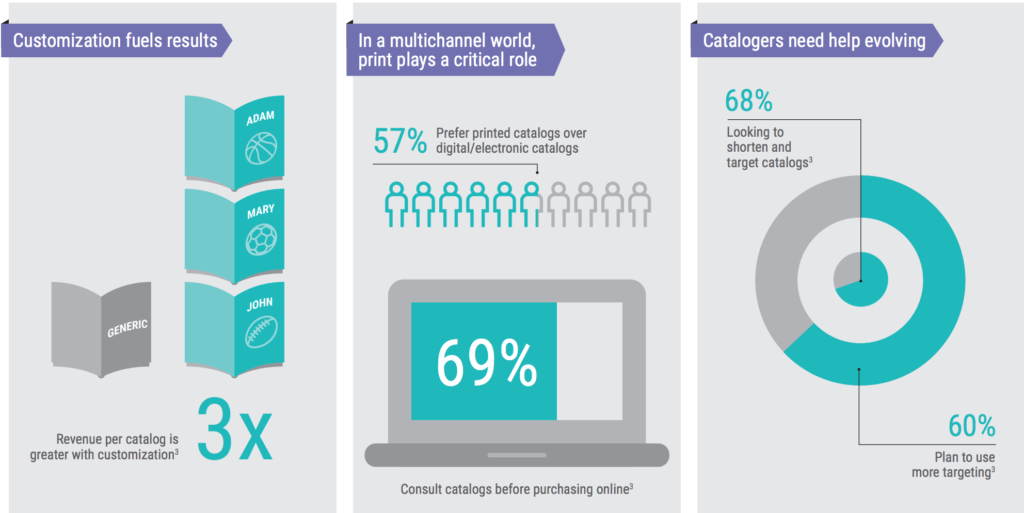Guest post by Shelley Sweeney, Vice President/General Manager Service Bureau/Direct Marketing @shelleysweeney
Direct mail isn’t the only “old school marketing” tool getting second looks today. Catalogs are also experiencing a revival. From a hyper-focus on digital marketing, the pendulum is swinging back to printed pieces like direct mail and catalogs. And they’re working.
In both B2B and B2C markets, printed catalogs have experienced a surprising resurgence as brands and marketers realize their power to impact buyer behavior. The catalog has been resurrected, and for marketers, it’s looking better than ever. In fact, these Cinderella pieces bear scant resemblance to traditional catalogs with page after page of product shots.
Marketers with money are turning to catalogs, but it’s not your father’s catalog. Think of a cross between coffee table book and high-end fashion magazine. Today’s generation of catalogs appeal to consumer lifestyles, and with so much marketing experienced online, catalogs stand out in the physical realm. They hang around for a while in the buyer’s life. Catalogs tell stories. They suggest ideas.
Printed Catalogs Drive Behavior and Generate Sales
Within the crowded universe of digital channels consumers use to consider and complete purchases, print plays a unique role. There’s no other way to replicate the tactile experience of flipping through a beautifully printed catalog. “Years ago it was a selling tool, and now it’s become an inspirational source,” said Craig Elbert, Bonobos’s vice president of marketing. “We know our customers love a tactile experience.”
What’s not to love about catalogs? For buyers, the lush photos and lifestyle imagery plant ideas and stimulate actions. Catalogs appeal across segments and generations. 65% of millennials have made purchases influenced by a catalog1. For sellers, the content can be highly motivating sales tools.
Other facts hammer home the catalog story:
- 69% of consumers consult a printed catalog before an online purchase.2
- Studies show that recipients view catalogs for an average of 30 minutes.3
- Catalogs influence an average of 2.5 purchases.3
- More than 77% of recipients visit a retail store due to a catalog promotion.3
Catalogs Have a Place in Multichannel Marketing
Multichannel marketers have also embraced catalogs, because data backs up their reputation for building relationships and driving purchases. A DMA study found that 59% of multichannel marketers had increased their catalog circulation from the year before, and that was research from 2015!
The printed retail catalog trend continues because it is:
- Affordable
- Possible
- Measurable
- Customizable
German retailer Bonprix reaches millions of customers across 29 countries with multichannel marketing that spans online, print and retail. Their printed catalog is their most critical channel. 220 million copies are distributed annually, and 69% of online shoppers consult the catalog first.
Bonprix wanted to understand the ROI of personalizing catalogs with targeted content. In a test, 300,000 catalogs were personalized on front and back covers with offers based on customer profiles and past purchases. Results included 500% higher response rates from current customers and 400% higher response rates from inactive customers. (Read “Catalogs: An Opportunity for Growth” to learn how these personalized communications were created.)
Four Ways to Get in the Catalog Game
As attractive as catalogs are, there’s a problem. Brands, marketers and agencies get overwhelmed by all the possible combinations of personalization, inks, papers, enhancements, construction and most importantly, multichannel integration. That can be intimidating for marketers and clients. They need someone to look across these choices and understand how to put them together to hit a goal.
It’s not too late to assess your catalog capabilities. New inkjet production technologies combine with data to take cost and complexity out of personalized catalog experiences. Here are four steps you can take to get in the game:
- Build competencies in scalable, integrated print and digital solutions.
- Invest to meet the technical demands of catalog manufacturing.
- Deliver consistent color for positive customer experience on every page.
- Demonstrate the benefits of personalization in the buying cycle.
For commercial printers, this next-gen catalog market is ripe, and it’s within your grasp. How many of these four steps have you taken? Start by downloading this guide from the Xerox Market Segment Series for an in-depth look at the catalog opportunity.
1 Direct Marketing Production Printing & Value-Added Services: U.S. Report, InfoTrends, 2015.
2 Xerox-InfoTrends Study
3 The Mail Moment, USPS, 2005
Feature image sources:
1 The Mail Moment, USPS, 2005; 2 DMA 2015 Response Rate Report; 3 Xerox-InfoTrends Catalog Research, 2015 All remaining data: Direct Marketing Production Printing & Value-Added Services: A Strategy for Growth, InfoTrends, 2015




Great Post! Thanks for sharing!
http://tholasiprints.com/